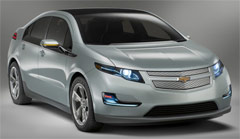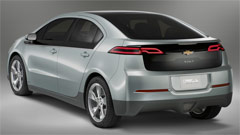
General Motors has unveiled the production version of the Chevrolet Volt, giving the world its first look at the highly anticipated plug-in hybrid.
Rick Wagoner, the chairman and CEO of GM, spoke of the unveiling of the Volt as a landmark in the history of GM, which is currently celebrating its hundredth year: "Revealing the production version of the Chevy Volt is a great way to open our second century. The Volt is symbolic of GM's strong commitment to the future ... just the kind of technology innovation that our industry needs to respond to today's and tomorrow's energy and environmental challenges."
The Volt, which promises to carry an electric charge for 40 miles before switching to its gasoline/E85-powered engine, provided unique design challenges to GM. To lengthen the effectiveness of the battery's charge, the aerodynamics of the Volt played a large role in its overall design and appearance.
GM's design teams spent hundreds of hours testing the Volt in wind tunnels to minimize the amount of power that would be needed to fight off wind resistance. The Volt's rounded and flush front fascia, tapered corners and grille were designed to enable air to move easily around the car. The sharp rear edges and carefully designed spoiler allow air to flow off the car quickly, and an aggressive rake on the windshield and back glass help reduce turbulence and drag.
The Chevrolet Volt is powered by more than 220 lithium-ion cells inside of its 16-kWh lithium-ion electric battery. Once the battery's initial charge is depleted after 40 miles, the gasoline/E85 engine kicks in and recharges the battery, allowing the Volt to travel for several hundred miles before it needs to be plugged in again to be recharged.
If you are wondering why the Volt has been engineered to carry an electric charge that will last for 40 miles, the answer is rather simple. Based on GM's research, the average commute between home and work for most Americans is 40 miles. Therefore, with the exception of the occasional longer drive, most Volt owners would only rarely use the gasoline/E85 engine of the car, making trips to the gas station few and far between.
The Chevrolet Volt can be plugged into a standard household 120 volt outlet or use a 240 volt outlet to be charged. The battery can be charged in about eight hours at 120 volts or in less than three hours at 240 volts, meaning that if you were to return home from work with an "empty" battery and plugged the Volt in overnight, it would be fully charged by morning.
By GM's estimates, a full charge of 40 miles will cost about 80 cents per day (at a rate of10 cents per kWh) - meaning that a day's worth of driving a Volt will be less expensive than a cup of coffee. Spread out over the course of a year, charging the Volt daily will consume less electricity than the average home's refrigerator and freezer units.
The Volt will deliver the equivalent of 150 horsepower, 273 lb-ft. (370 Nm) of instant torque, and a top speed of 100 miles per hour. Because it is powered by electricity and not by a traditional gasoline engine, combined with the use of special sound-deadening materials, the Volt will be an extremely quiet vehicle to drive.
Production of the Volt is scheduled to begin late 2010 at GM's Detroit-Hamtramck manufacturing facility. Pricing has not yet been announced.

